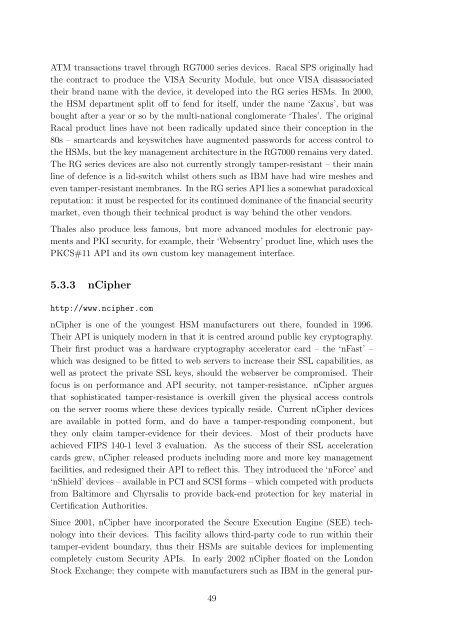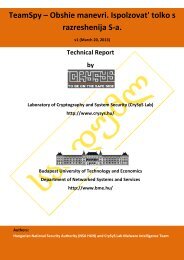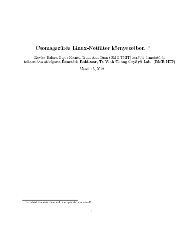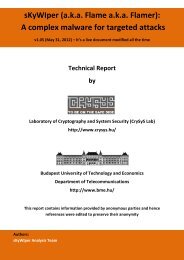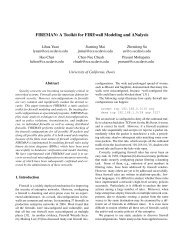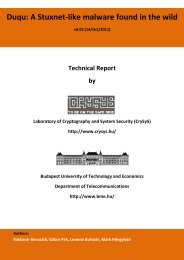Understanding Security APIs - CrySyS Lab
Understanding Security APIs - CrySyS Lab
Understanding Security APIs - CrySyS Lab
Create successful ePaper yourself
Turn your PDF publications into a flip-book with our unique Google optimized e-Paper software.
ATM transactions travel through RG7000 series devices. Racal SPS originally had<br />
the contract to produce the VISA <strong>Security</strong> Module, but once VISA disassociated<br />
their brand name with the device, it developed into the RG series HSMs. In 2000,<br />
the HSM department split off to fend for itself, under the name ‘Zaxus’, but was<br />
bought after a year or so by the multi-national conglomerate ‘Thales’. The original<br />
Racal product lines have not been radically updated since their conception in the<br />
80s – smartcards and keyswitches have augmented passwords for access control to<br />
the HSMs, but the key management architecture in the RG7000 remains very dated.<br />
The RG series devices are also not currently strongly tamper-resistant – their main<br />
line of defence is a lid-switch whilst others such as IBM have had wire meshes and<br />
even tamper-resistant membranes. In the RG series API lies a somewhat paradoxical<br />
reputation: it must be respected for its continued dominance of the financial security<br />
market, even though their technical product is way behind the other vendors.<br />
Thales also produce less famous, but more advanced modules for electronic payments<br />
and PKI security, for example, their ‘Websentry’ product line, which uses the<br />
PKCS#11 API and its own custom key management interface.<br />
5.3.3 nCipher<br />
http://www.ncipher.com<br />
nCipher is one of the youngest HSM manufacturers out there, founded in 1996.<br />
Their API is uniquely modern in that it is centred around public key cryptography.<br />
Their first product was a hardware cryptography accelerator card – the ‘nFast’ –<br />
which was designed to be fitted to web servers to increase their SSL capabilities, as<br />
well as protect the private SSL keys, should the webserver be compromised. Their<br />
focus is on performance and API security, not tamper-resistance. nCipher argues<br />
that sophisticated tamper-resistance is overkill given the physical access controls<br />
on the server rooms where these devices typically reside. Current nCipher devices<br />
are available in potted form, and do have a tamper-responding component, but<br />
they only claim tamper-evidence for their devices. Most of their products have<br />
achieved FIPS 140-1 level 3 evaluation. As the success of their SSL acceleration<br />
cards grew, nCipher released products including more and more key management<br />
facilities, and redesigned their API to reflect this. They introduced the ‘nForce’ and<br />
‘nShield’ devices – available in PCI and SCSI forms – which competed with products<br />
from Baltimore and Chyrsalis to provide back-end protection for key material in<br />
Certification Authorities.<br />
Since 2001, nCipher have incorporated the Secure Execution Engine (SEE) technology<br />
into their devices. This facility allows third-party code to run within their<br />
tamper-evident boundary, thus their HSMs are suitable devices for implementing<br />
completely custom <strong>Security</strong> <strong>APIs</strong>. In early 2002 nCipher floated on the London<br />
Stock Exchange; they compete with manufacturers such as IBM in the general pur-<br />
49


